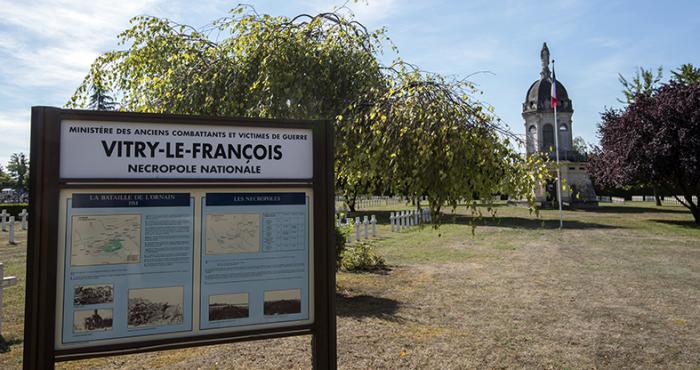
La nécropole nationale de Vitry-le-François. © ECPAD
Pour accéder au panneau d'information de la nécropole, cliquer ici 
The Vitry-le-François cemetery - which was created in 1921 in order to welcome the bodies of soldiers exhumed from temporary military cemeteries and isolated graves in the Perthois area or from the town's military hospitals - brings together the bodies of nearly 4,000 soldiers who died for France, 2,558 of whom lie in an ossuary. Seven British soldiers who died between 1914 and 1918 are also buried here. The bodies of 62 French soldiers from the Second World War, who were from this area and the Haute-Marne, were also brought here.
Vitry-le-François was at the centre of the fighting during the first Battle of the Marne. Following the French victory, it became one of the conflict's most important relief centres. Located 60 km behind the front, this "hospital town" took in between 2,000 and 3,000 wounded in around 10 medical facilities during the major offensives.
During the war, the inhabitants of Vitry-le-François maintained the graves and welcomed and provided information to the bereaved families. A chapel dedicated to the Blessed Virgin Mary was erected between 1920 and 1921. In the foundations of this monument - which stands at the centre of the cemetery - lie the mortal remains of 1,127 unknown soldiers who were exhumed from the cemeteries at Blesmes and the Mont-Moret. There is a plaque on the dome in memory of the 304 inhabitants of Vitry who died for France between 1914 and 1918.
In April 1915, following the violent battles at the Hurlus, four soldiers were accused of intentional self-mutilation. Tried for "abandoning their posts", they were shot at Saint-Amand-sur-Fion on the morning of 3 April 1915. The war writer Maurice Bedel, who was awarded the Prix Goncourt (French literary prize) in 1927, recounts the story of this execution. Their names were not cleared.
The remains of these four men lie in this cemetery: Lucien Mervelay, soldier with the 174th infantry regiment (RI) aged 29, Louis Grard, soldier with the 127th RI aged 22, Charles Cailleretz, private with the 8th RI aged 25 and Marcel Pollet, soldier with the 72nd RI aged 25. The bodies of the four soldiers, who were previously buried in the temporary military cemetery at Courdemanges, have lain in the ossuary of the national cemetery since August 1922.